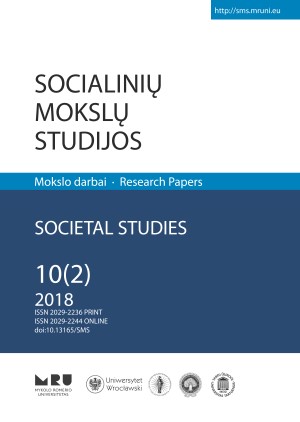BALTŲ IR KRIKŠČIONIŠKŲJŲ SIMBOLIŲ ESTETINĖ TRANSFORMACIJA PETRO DIRGĖLOS „KARALYSTĖJE“
THE AESTHETIC TRANSFORMATION OF THE BALTIC AND CHRISTIAN SYMBOLS IN PETRAS DIRGELA’S “THE KINGDOM”
Author(s): Vytautas MartinkusSubject(s): Lithuanian Literature
Published by: Mykolas Romeris University
Keywords: aesthetics; symbol; Baltic religion; Christian values; epic;
Summary/Abstract: This article deals with the epic “The Kingdom” by Petras Dirgėla, a historical work of literature in 14 parts (books) as a subject of multivariable senses of faith (esteem). The significance of these symbols as religious aesthetic (literary) values is analysed. The aim of the article is to discuss the relationship between religious symbols from different epochs (pre-Christian and Christian) and their transformation into aesthetic values in the historical novel. The research seeks to examine the change in symbolic values of religion in the historical Lithuanian novel as a subject of different cultural symbols.The research seeks to address the questions: 1) Can symbols of a Baltic religion changed to Christian ones essentially affect the form of epic work? 2) Which symbols of the Baltic religion in the epic “The Kingdom” are most important to the narrator in establishing the kingdom’s literary world? 3) How does the novel transform the religious symbols into aesthetic (literary) values? Answering the questions raised is an important aesthetic issue of Lithuanian philosopher Juozas Mureika (the theory of aesthesis). The article proposes the following conclusions. The Baltic and Christian symbols in the novel “The Kingdom” are equally important to its literary form. The structure of the work (form) and the traits of narrative poetics are determined by the fundamental value of any faith – the connection between the road of earthly human life and the kingdom of heaven (the spiritual). The historical interrelationships between the symbols of different religions increase the multiplicity of poetic means (such as symbols, metonymy and metaphors) and their aesthetic effect in literary works. One of the most important symbols that actively determines the structure of an epoch`s boundaries is water and a path. Their variables are sea and lake, road and passenger. The last most significant element in the novel is the symbol of the tree (or forest). From an aesthetic perspective, it is not only the significance of these (and all other) symbolic signs that is important, but also their “architectonics”, through which the reader experiences the whole set of symbols of a work and establishes new archetypal meanings.
Journal: Socialinių mokslų studijos
- Issue Year: 10/2018
- Issue No: 2
- Page Range: 205-218
- Page Count: 14
- Language: Lithuanian

